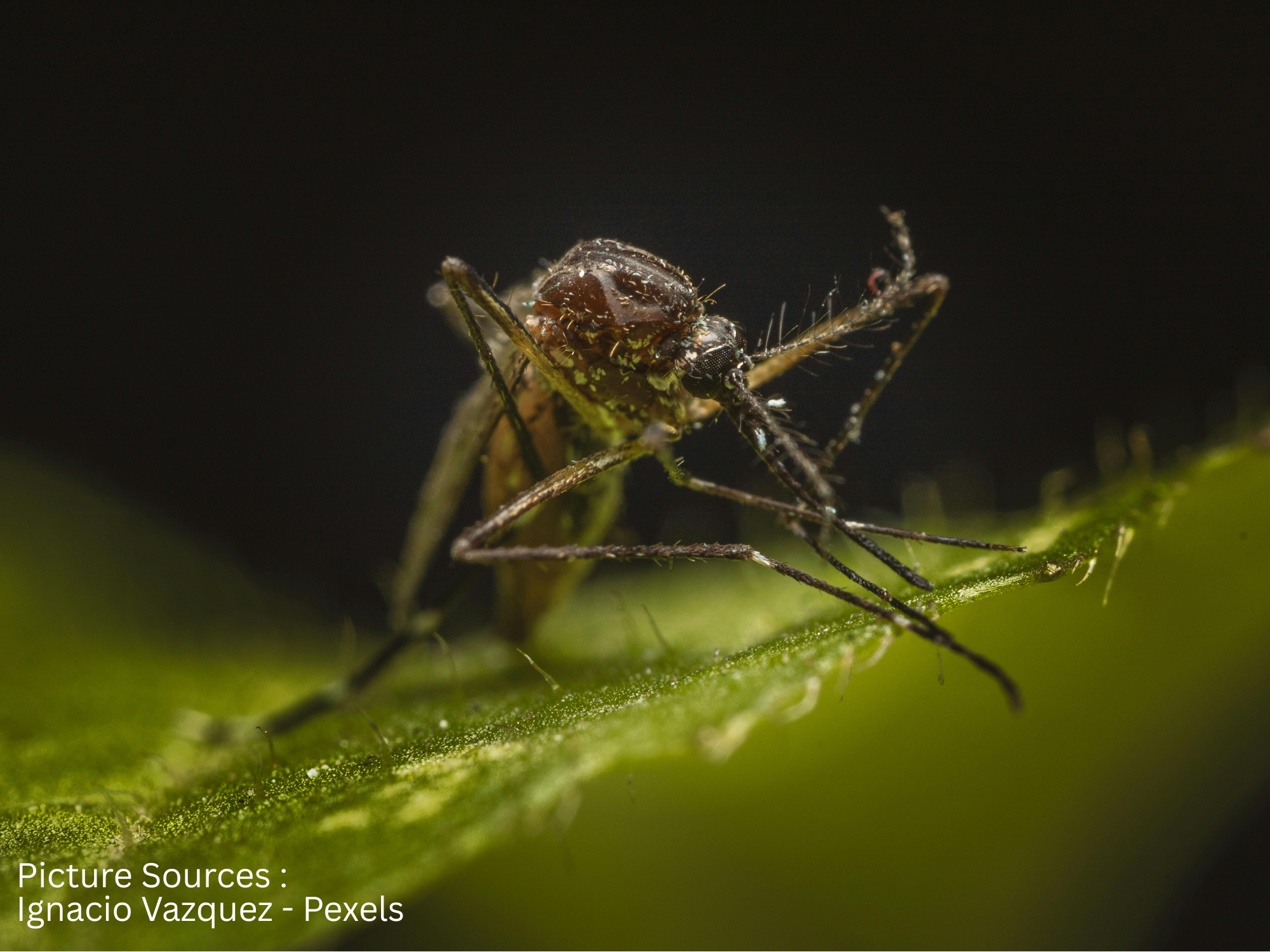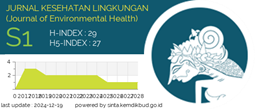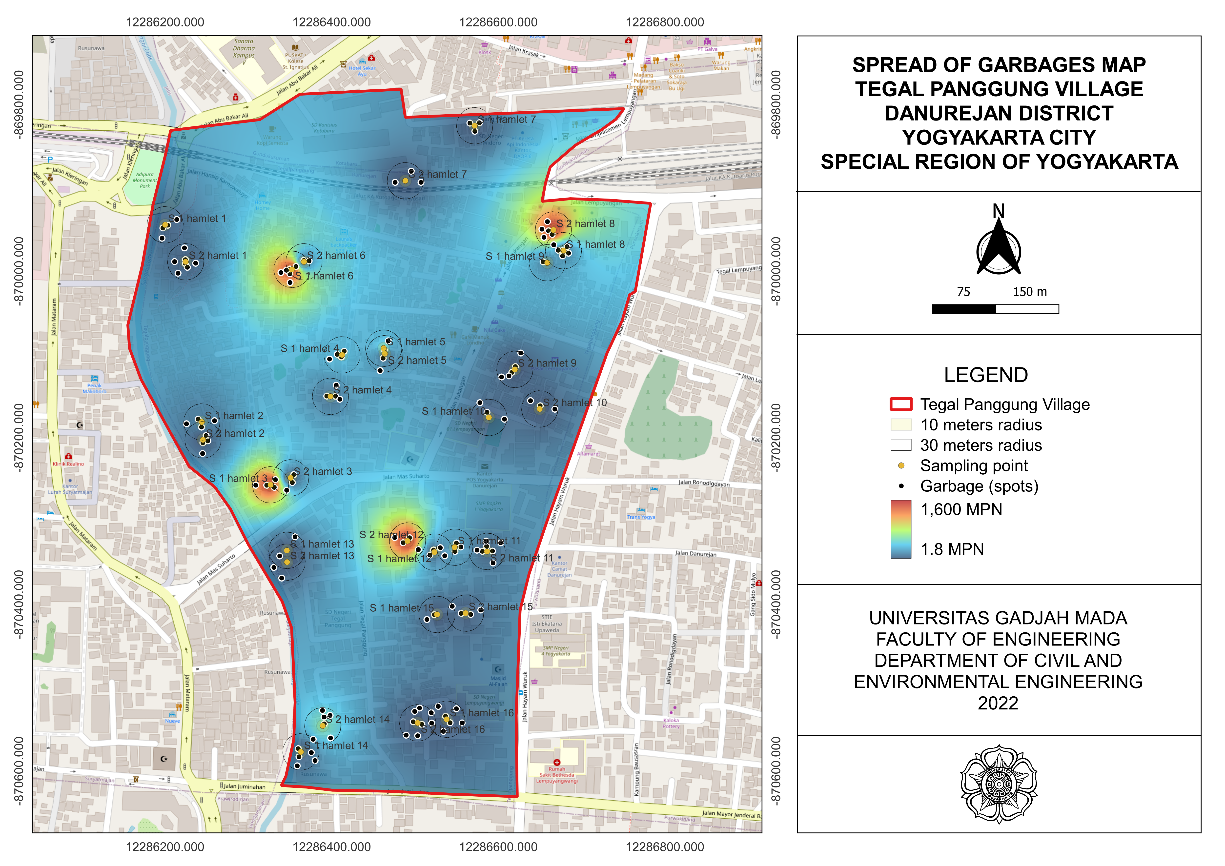Analysis of Environmental Risk Factors Associated with Malaria Incidence in Papua, Indonesia

Introduction: Papua is the region with the highest malaria burden in Indonesia, accounting for about 84% of the total national malaria cases. The high incidence rate indicates the need for a multidimensional approach, including analysis of environmental determinants. Therefore, this study aimed to evaluate the influence of environmental risk factors on the incidence of malaria in Papua, Indonesia. Methods: A cross-sectional observational design was used based on secondary data from the 2023 Indonesian Health Survey. The analysis was conducted on 37,987 respondents using Chi-square test and binary logistic regression. The variables analyzed included housing conditions, physical quality of water, wastewater drainage systems, and waste management. Results and Discussion: The results showed that, based on bivariate analysis, four environmental factors were significantly related to malaria incidence (p<0.05). However, in the multivariate analysis, only three variables remained significant, wastewater drainage system (OR=1.203; p<0.001), poor waste management practices (OR=1.103; p<0.016), and housing conditions (OR=0.884; p<0.001). while water quality had no significant effect. Conclusion: These findings highlight the importance of incorporating environmental management into malaria control strategies, especially in endemic and resource limited regions like Papua, through multisectoral collaboration between health and environmental authorities.
Pravallika G, Kumari MS, Aasritha D, Vandana G, Suswitha G. Malaria Parasite Detection System using Deep Learning and Image Processing. Int J Adv Res Ideas Innov Technol. 2021;7(3):2413–2420. https://www.ijariit.com/papers/malaria-parasite-detection-system-using-deep-learning-and-image-processing/
Palapessy VE. Penyuluhan Pencegahan Penularan Penyakit Malaria Kepada Masyarakat di Desa Kampung Baru Kelurahan Galang Baru Kota Batam. J Masy Mengabdi Nusant. 2024;3(1):55–62. https://doi.org/10.58374/jmmn.v3i1.244
Madayanti S, Raharjo M, Purwanto H. Faktor Risiko yang Mempengaruhi Kejadian Malaria di Wilayah Distrik Jayapura Selatan Kota Jayapura. J Kesehatan Lingkungan Indonesia. 2022;21(3):358–365. https://doi.org/10.14710/jkli.21.3.358-365
Kementerian Kesehatan Republik Indonesia. Profil Kesehatan Indonesia 2023. Jakarta: Kementerian Kesehatan RI; 2024. https://kemkes.go.id/id/profil-kesehatan-indonesia-2023
Arisjulyanto D, Kusuma AH, Lestari DP, Suharmanto, Ilmidin. Pengaruh Penyuluhan Menggunakan Media Leaflet Terhadap Tingkat Pengetahuan Masyarakat Tentang Pencegahan Malaria. Jurnal Farmasi Indonesia. 2025;18(2):88–97. https://prin.or.id/index.php/JURRIKE/article/view/5699
Kumala I, Roroa S, Agustina U. Analysis of House Sanitation and Hygiene With Malaria Incidence in Nerong Village , Kei Besar Selatan District , Maluku Regency Southeast. International Journal of Nursing and Education Research. 2025;8(1):33–41. https://doi.org/10.30994/ijner.v8i1.326
Nikiema S, Soulama I, Ampofo GD, Nikiema M, Zouré AA, Sombié S. Influence of Genetic Factors of Humans, Mosquitoes and Parasites, on The Evolution of Plasmodium Falciparum Infections, Malaria Transmission and Genetic Control Methods: A Review of the Literature. BMC Med Genomics. 2025;18(1): 1–16. https://doi.org/10.1186/s12920-025-02165-w
WHO. World Malaria Report 2023. Geneva: World Health Organization;2023. https://www.wipo.int/amc/en/mediation/%0Ahttps://www.who.int/teams/global-malaria-programme/reports/world-malaria-report-2023
Mohammed K, Salifu MG, Batung E, Amoak D, Avoka VA, Kansanga M. Spatial Analysis of Climatic Factors and Plasmodium Falciparum Malaria Prevalence Among Children in Ghana. Spat Spatiotemporal Epidemiol. 2022;43(100537): 1-11. https://doi.org/10.1016/j.sste.2022.10053710. Jamal Q, Rasheed SB, Khan NH. An Exploratory Case Study of the Effect Of Ecology on Malaria Risk Factors in Northern Pakistan. Research Square. 2025;4(10020):1–12. https://doi.org/10.21203/rs.2.24018/v1
Wafula ST. Pathways Linking Socioeconomic Position and Malarial Infection and Healthcare-Seeking Behaviour for Suspected Malaria in Sub-Saharan Africa. Dissertation. Hamburg: University of Hamburg; 2025. https://ediss.sub.unihamburg.de/handle/ediss/11572
Francisco ME, Watanabe K. Innovative House Structures for Malaria Vector Control in Nampula District, Mozambique: Assessing Mosquito Entry Prevention, Indoor Comfort, and Community Acceptance. Front Public Heal. 2024;12(3):1–11. https://doi.org/10.3389/fpubh.2024.1404493
Cofone L, Sabato M, Paolo CD, Giovanni S Di, Donato MA, Paglione L. Urban , Architectural , and Socioeconomic Factors Contributing to the Concentration of Potential Arbovirus Vectors and Arbovirosis in Urban Environments from a One Health Perspective : A Systematic Review. Sustainability. 2025;17(9):1–25. https://doi.org/10.3390/su17094077
Chopra H, Bibi S, Singh I, Hasan MM, Khan MS, Yousafi Q, et al. Green Metallic Nanoparticles: Biosynthesis to Applications. Frontiers in Bioengineering and Biotechnology. 2022;10:1–29. https://doi.org/10.3389/fbioe.2022.874742
Farias MFD, Figueiredo ERL, Silva RNSD, Galhardo DDR, da Silva CL, Moreira EMF. Malaria Mortality in Brazil: Age–Period–Cohort Effects, Sociodemographic Factors, and Sustainable Development Indicators. Trop Med Infect Dis. 2025;10(2):123–134. https://doi.org/10.3390/tropicalmed10020041
Msugupakulya BJ, Mhumbira NS, Mziray DT, Kilalangongon M, Jumanne M, Ngowo HS, et al. Entomological Surveys in Rural Tanzania Reveal Key Opportunities for Targeted Larval Source Management to Control Malaria in Areas Dominated by Anopheles funestus. Malar J. 2024;23(344):1–17. https://doi.org/10.1186/s12936-024-05172-x
Babawo LS, Kpaka RB, Sesay DKD. Assessment of Malaria Treatment Interventions: A Critical Analysis of Government Initiatives and Causes of Treatment Failure at Port Loko Government Hospital, Sierra Leone. Malar J. 2025;24(1):83–91. https://doi.org/10.1186/s12936-025-05330-9
Khairiyati L, Marlinae L, Waskito A, Rahmat AN, Ridha MR, Andiarsa D. Buku Ajar Pengendalian Vektor dan Binatang Pengganggu. Yogyakarta: CV Mine; 2021. https://repo-dosen.ulm.ac.id//handle/123456789/21770
Ahmad Z, Esposito P, Ali M. The Risk Factors and Problems of Waste Management in Developing Countries as Hurdles. Qlantic J Soc Sci. 2025;6(1):130–144. https://doi.org/10.55737/qjss.vi-i.25298
Badan Kebijakan Pembangunan Kesehatan. Survei Kesehatan Indonesia (SKI) Tahun 2023. Jakarta: Kementerian Kesehatan RI; 2024. https://kemkes.go.id/id/survei-kesehatan-indonesia-ski-2023
Fambirai T, Chimbari M, Mhindu T. Factors Associated with Contracting Border Malaria: A Systematic and Meta-Analysis. PLoS One. 2025;20(1):1–18. https://doi.org/10.1371/journal.pone.0310063
Badan Penelitian dan Pengembangan Kesehatan. Alur Proses Manajemen Data Laboratorium-1. Jakarta: Balitbankes. 2021;1–108. https://repository.badankebijakan.kemkes.go.id/id/eprint/4304
Shafagh ME, Mirzagholipour M, Salehi SA, Esmaeili SV, Karami C. Impact of Global Climate-Change on Ecology of Anopheles Mosquitoes: A Systematic Review. Iran J Public Health. 2025;54(3):542–553. https://doi.org/10.18502/ijph.v54i3.18247
Rozi IE, Syahrani L, Permana DH, Asih PBS, Sumiwi ME, Lobo NF, et al. Gaps in Protection to Anopheles Exposure in High Malaria Endemic Regencies of Papua Province, Indonesia. PLoS One . 2025;20(4):1-19. https://doi.org/10.1371/journal.pone.0311076
Nundu SS, Culleton R, Simpson SV, Arima H, Muyembe JJ, Mita T, et al. Malaria Parasite Species Composition of Plasmodium Infections Among Asymptomatic and Symptomatic School-Age Children in Rural and Urban Areas of Kinshasa, Democratic Republic of Congo. Malar J. 2021;20(1):1-13. https://doi.org/10.1186/s12936-021-03919-4
Pfeifer C, Knetsch S, Maercker J, Mustafa O, Rümmler MC, Brenning A. Exploring the Potential of Aerial Drone Imagery to Distinguish Breeding Adélie (Pygoscelis Adeliae), Chinstrap (Pygoscelis Antarcticus) and Gentoo (Pygoscelis Papua) Penguins in Antarctica. Ecol Indic. 2025;170:1-15. https://doi.org/10.1016/j.ecolind.2024.113011
Castro MC, Kanamori S, Kannady K, Mkude S, Killeen GF, Fillinger U. The Importance of Drains for the Larval Development of Lymphatic Filariasis and Malaria Vectors in Dar Es Salaam, United Republic of Tanzania. PLoS Negl Trop Dis. 2020;4(5):1-12. https://doi.org/10.1371/journal.pntd.0000693
Chaves LF, Ramírez Rojas M, Delgado Jiménez S, Prado M, Marín Rodríguez R. Housing Quality Improvement is Associated with Malaria Transmission Reduction in Costa Rica. Socio Econ Plan Sci. 2021;74:100951. https://doi.org/10.1016/j.seps.2020.100951
Musiime AK, Krezanoski PJ, Smith DL, Kilama M, Conrad MD, Otto G, et al. House Design and Risk of Malaria, Acute Respiratory Infection and Gastrointestinal Illness in Uganda: A Cohort Study. PLOS Global Public Health. 2022;2(3):1–19. https//.doi.org/10.1371/journal.pgph.0000063
Somé AF, Somé A, Sougué E, Ouédraogo COW, Da O, Dah SR. Safety and Efficacy of Repeat Ivermectin Mass Drug Administrations for Malaria Control (RIMDAMAL II): A Phase 3, Double-Blind, Placebo-Controlled, Cluster-Randomised, Parallel-Group Trial. Lancet Infect Dis. 2025;25(5):150-160. https://doi.org/10.1016/S1473-3099(24)00751-531
Fazeli-Dinan M, Azarnoosh M, Özgökçe MS, Chi H, Hosseini-Vasoukolaei N, Haghi FM. Global Water Quality Changes Posing Threat of Increasing Infectious Diseases, A Case Study on Malaria Vector Anopheles Stephensi Coping with the Water Pollutants Using Age-Stage, Two-Sex Life Table Method. Malar J. 2022;21(1):1–16. https://doi.org/10.1186/s12936-022-04201-x
Minawati AD, Ramadhani DNAM, Damayanti S, Ariska YGE, Murti B, Handayani AF. Effects of Insecticide-Treated Nets and Stagnant Water on the Risk of Malaria: A Meta-Analysis. J Epidemiology Public Health. 2023;8(3):362–374. https://doi.org/10.26911/jepublichealth.2023.08.03.07
Kinuthia GK, Ngure V, Kamau L. Urban Mosquitoes and Filamentous Green Algae: Their Biomonitoring Role in Heavy Metal Pollution in Open Drainage Channels in Nairobi Industrial Area, Kenya. BMC Ecol Evol. 2021;21(1):1–15. https://doi.org/10.1186/s12862-021-01913-7
Sembiring LN, Wandikbo S. Hubungan Lingkungan dengan Kejadian Malaria pada Masyarakat di Kampung Nawaripi Kabupaten Mimika Provinsi Papua. Pros STIKES Bethesda. 2023;2(1):136–146. https://jurnal.stikesbethesda.ac.id/index.php/p/article/view/427/291
Bayode T, Siegmund A. Social Determinants of Malaria Prevalence Among Children Under Five Years: A Cross-Sectional Analysis of Akure, Nigeria. Sci African. 2022;16(e01196):1-11. https://doi.org/10.1016/j.sciaf.2022.e01196
Nammu M, Adu AA, Ndoen HI. Malaria Mapping Based on Patients’ Characteristic, Mosquito Breeding Place and Insecticide-Treated Net Use in The Work Area of Radamata and Waimangura Health Center of Sumba Barat Daya District. Media Kesehat Masy. 2022;4(3):294–305. https://doi.org/10.35508/mkm.v4i3.7415
Okin YK, Yabar H, Kevin KL, Mizunoya T, Higano Y. Geospatial Analysis of Malaria and Typhoid Prevalence Due to Waste Dumpsite Exposure in Kinshasa Districts with and without Waste Services: A Case Study of Bandalungwa and Bumbu, Democratic Republic of Congo. Int J Environmental Research and Public Health. 2024;21(11):1–13. https://doi.org/10.3390/ijerph21111495
Kitole FA, Ojo TO, Emenike CU, Khumalo NZ, Elhindi KM, Kassem HS. the Impact of Poor Waste Management on Public Health Initiatives in Shanty Towns in Tanzania. Sustainability. 2024;16(24):1–26. https://doi.org/10.3390/su162410873
Hilma SI, Ardillah Y, Sunarsih E. Identifikasi Spesies Larva Anopheles pada Genangan Air: Survey Habitat Alami di Kecamatan Gunung Megang, Kabupaten Muara Enim, Sumatera Selatan. J Kesehatan Masyarakat Indonesia. 2023;18(2):1–8. https://jurnal.unimus.ac.id/index.php/jkmi
Kamanda JS. The Impacts of Poor Sanitation on Malaria Incidence Among Residents of Paynesville, Montserrado County, Liberia. Vidhyayana J. 2024;10(1):348-362. https://j.vidhyayanaejournal.org/index.php/journal/article/view/1964

This work is licensed under a Creative Commons Attribution-NonCommercial-ShareAlike 4.0 International License.
1. Copyright of all journal manuscripts is held by the Jurnal Kesehatan Lingkungan.2. Formal legal provisions to access digital articles of electronic journal are subject to the provision of the Creative Commons Attribution-ShareAlike license (CC BY-NC-SA), which means that Jurnal Kesehatan Lingkungan is rightful to keep, transfer media/format, manage in the form of databases, maintain, and publish articles.
3. Published manuscripts both printed and electronic are open access for educational, research, and library purposes. Additionally, the editorial board is not responsible for any violations of copyright law.
JKESLING by UNAIR is licensed under a Creative Commons Attribution-ShareAlike 4.0 International License.







































